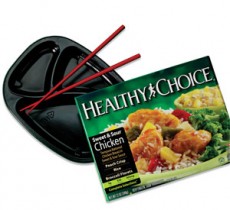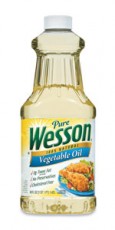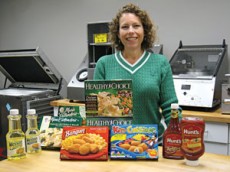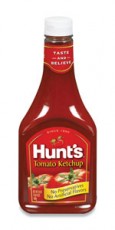 |
 |
Packaging Digest: As one of the nation's largest food processors and merchandisers, can you estimate how many packages and package designs ConAgra produces each year?
Tavill: This is one of the hardest questions because the answer is a lot. We have more than 4,000 SKUs among our consumer goods. In two main entities, we have consumer goods and commercial goods. I don't touch all of them every year, but that's a lot of complexity and a lot of packaging because everything in our consumer goods is packaged food. Within consumer foods, we have four different divisions: grocery, snacks, refrigerated and frozen. So there are different temperature stages and different distribution environments.
A lot of packaging goes along with that. I literally hit every medium there is in the food packaging industry. There's nothing we don't play with.
What about packaging for institutional items?
 |
| Gail Tavill, who leads ConAgra Food's sustainable packaging program as vp of sustainable development research, displays packages that she says are helping the company meet its goals. |
How long has ConAgra had a sustainability program?
One of the things I like about ConAgra is that we've had a sustainability development program in place since the early '90s. I think it was 1992 when we kicked off our sustainable developments award program. We've just been very quiet about it. It was put in place to recognize the good work going on in manufacturing and research and development on water, energy, waste, good packaging design and good marketing around environmental issues. It was a pretty well thought-out awards program that came with a conference where people being recognized made presentations to share best practices. We're revamping it and kicking it off again during Earth Month next year.
We are considering adding an external component for sustainable supplier of the year. We don't know what that will look like yet, but we have alignment from our procurement organization.
Does ConAgra have an established, formal sustainability policy?

It is formal in the sense that we've built a training deck that we have presented to the technical professionals in our organization. It's written to explain our expectations and our decision hierarchy. In terms of the total intention of the policy, it lines up extremely well with the Sustainable Packaging Coalition's guidelines.
What are some of the major goals for packaging sustainability that ConAgra plans?
This is really pretty important to me. The sustainability goals that Conagra has are really more big-picture goals. We do have some goals about packaging, but one of the things that has become very clear to us in the last year is that sustainability is a much, bigger challenge than just packaging. So packaging is an enabler. It's an enabler to deliver safe, healthy and convenient products.
How does ConAgra decide which products it moves toward more sustainable packaging?
Every company has a prioritization process, and we're no different. We're always looking for new ideas and applications for new technologies. Clearly, we consider the strategies of our brands and where sustainability considerations or potential packaging claims fit within those brands. We also look for where we can drive the biggest impact for the lowest investment. It really comes down to where is our biggest return on investment? That ROI could be a financial ROI or it could be an intangible ROI, but we're always looking for where we can get the biggest bang for our buck and tie that to our brand strategy.
Does ConAgra view sustainability as an environmental or an economic issue?
Clearly, it's both. There needs to be an ROI. Some of it may be intangible, but there's a benefit to intangibles around brand recognition and believability. The most important thing I can say about this is that I don't consider sustainability to be a cause. As soon as it's a cause, it's a fringe issue, and it's not going to get the resources or attention that it needs. It's a business strategy and a business opportunity. I have not seen any shortage of sustainability ideas that have economic advantages, as well as environmental benefits. We still have plenty of fruit to pick here.
Do these design changes you're making happen when a new product is introduced or do you revisit existing products?
In the recent past, I'd have to say our attention has been more on optimizing existing products. We have done a lot of work on new technologies and new ways of looking at things to optimize current product lines. One of the things we have done in the last year is to embed sustainability measures and principles in our new product development process. That was a really fun opportunity to get those considerations into the process so that we can design sustainability in from the beginning. We have begun training our packaging engineers who work in new product development on what sustainability is, what it means for packaging and what are the design guidelines they should follow for sustainable packaging. We've done quite a bit of consulting with that team on how to make decisions that are indicative of sustainability opportunities for new product design.
ConAgra recently announced that it is incorporating post-consumer-recycled PET into its frozen foods meal trays. What would you say are the benefits of this program?
 |
Was establishing the RPET sourcing the biggest challenge in this project?
We didn't go out and say we wanted to find a recycled material for our frozen trays. We were approached and told, 'We may have a source of materials. Would you be interested?' So it wasn't us pulling the technology forward. It was someone else saying that they might have something.
The funny thing is, now that we are commercial, those folks said they'd had approached other people for several years. We were the first ones to actually jump on board.
Was there any problem with meeting Food and Drug Administration guidelines on packaging for direct-food contact?
Actually, no. The biggest challenge was doing all the testing. There was a lot of testing required, and it's pretty well-documented what kinds of data and documentation you must provide. Frankly, our supplier did the vast majority of the work.
Do you have any specific sustainability guidelines for the new product introductions?
We are actually trying to follow the Sustainable Packaging Coalition's guidelines for new packaging development. We've worked with our internal resources to help them understand how to consider and apply those guidelines. I also have a very small team strictly focused on sustainable packaging. Those folks routinely consult internally on packaging innovation and commercialization.
How much do consumer demands and retailer demands affect ConAgra's sustainability practices?
I would say retailer demand is probably a higher order of magnitude right now just because of the Walmart involvement in this issue. The sustainable packaging scorecard and the packaging Sustainable Value Networks at Walmart have driven a tremendous amount of awareness around the issue.
I wouldn't say consumers are demanding sustainable packaging but they are accepting it now. The demand might come, and I would like to plan for that eventuality. I think consumers are still really confused. They don't understand all the messages they are being given. We have a very steep road to climb to get consumers to really understand what the sustainability issues are and how we can provide them with products and packaging to satisfy their desires to suport sustainability.
Describe some of ConAgra's successes in sustainable packaging?
There are two I can talk about openly because they've gotten quite a bit of public attention.
One is Hunt's Catsup, which won an Institute of Packaging Professionals' AmeriStar award in the sustainability category. That's a project where we strategically decided to convert from the industry-standard, multilayer EVOH barrier bottle for ketchup to a monolayer bottle using an oxygen-scavenging technology.
It was just a smart thing to do because it made the package more recyclable but also smart because going to a mono-layer bottle allows you to simplify your tooling. This enables lightweighting because it's much easier to lightweight a monolayer structure than a multilayer structure.
It can allow you to add to your bottle with embossing or debossing because your tooling is easier. And it provides a consumer advantage because a monolayer bottle can never delaminate. I don't think anybody who has bought a ketchup bottle hasn't heard that weird squeak and wondered what it was.
We were able to gain a competitive advantage and get recognized for it in the industry.
There's another package that we really haven't talked about in terms of sustainability but it fits the bill. Last summer, we converted all of our Wesson oils from round bottles to rectangular bottles. We had been fairly stubborn in the marketplace, keeping our round bottles because we thought it was an equity advantage vs. the competition. Then we made the commitment to go rectangular, which was a huge sustainability advantage in cube utilization on the shelf, in secondary packaging and in transport packaging.
And because we changed some of our supply chain we also were able to optimize the bottles in terms of the weight and materials. On average, we saved 30 to 40 percent in terms of transportation efficiencies. One big advantage is that they pack out much better on shelves, so we also get less out-of-stocks.
I have probably 60 examples of source reductions I could talk about, but all packagers are doing those. We're all continuing to do improvement projects. It's just what packaging people do.
Should packagers have to prove their sustainability claims?
I think, absolutely, we must have substantiation. Without it, consumers are going to continue to be confused and won't understand what this all means. We are not claiming anything we cannot back up with facts. I don't want to be accused of “greenwashing” in this environment. It would just be detrimental. If you do 15 good things and one that is questionable, somebody will call you on the carpet for the one that's questionable and you won't get any credit for the good things you did.
I, personally, would like to see the Federal Trade Commission have more teeth to enforce its new guidelines when they're published.
Is ConAgra conducting a lot of its own packaging R&D, or are you relying on your vendors to provide you with innovations?
We're not being shy about looking under rocks. We're looking internally, externally, backwards and forward in our supply chain.
If you take the ketchup bottle and frozen food tray ideas, those came from our suppliers. But we weren't shy about pursuing them.
We have so much enthusiasm in the company around this issue that ideas are coming from all over the place. Our problem isn't finding ideas, it's deciding which ones we want to work on first. We're doing a lot of talking and a lot of listening to try and figure out the best possibilities to drive the biggest impacts.
Has it been difficult for ConAgra to establish sustainability metrics?
When I started looking at this issue, it was the hardest thing to determine what we should track. You can't improve on something you don't measure.
We talked about measuring weight. We talked about measuring recycled content or recyclability. There are so many things you can measure.
We talked about measuring weight. And we talked about measuring recycled content or recyclability. It was difficult to land on what was the most important and then put systems into place to measure those.
The Sustainable Packaging Coalition has helped tremendously. I've looked to them for leadership for me and the industry. If I measure things that my peers, suppliers and customers don't, then I don't know how useful that is. I think the SPC offers a tremendous value in that regard.
We're also looking at the Global Reporting Intiative, which has pretty significant reporting standards, with modules they're adding for packaging and products.
Are there certain types of packaging that are easier to make more environmentally friendly?
No. The best package is the one that delivers the right advantage to the product. Every product has its own set of requirements and consumer needs. There is no silver bullet. The important thing is that we make educated decisions about the impact of the choices we make and use the tools available to us to make those decisions through a sustainable lens.
Tel:886-2-28941823 Fax:886-2-28941837 E-mail:viya@packsourcing.com
Copyright Notice © 2015 New Insight Publishing Ltd.. All rights reserved.
Powered by Packsourcing